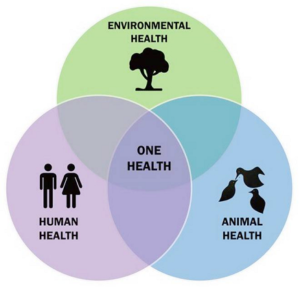How can ‘One Health’ help India, and India help ‘One Health’?
Relevance
- GS Paper – 2, Health, Government Policies & Interventions.
- Tags: #upsc #health #governmentpolicies #Ayushmanbharat.
Why in the news?
The concept of ‘One Health’ is currently gaining popularity worldwide; India has of late been taking significant strides to deploy concepts and strategies rooted in this idea to bolster the way it responds to health crises.
One Health concept
- One Health is a holistic approach to problems that recognizes the interconnections between the health of humans, animals, plants, and their shared environment.
- An early articulation can be found in the writings of Hippocrates (460-367 BC), who contemplated the relationships between public health and clean environments.
- The 19th-century German physician and pathologist Rudolf Virchow (1821-1863) later wrote: “Between animal and human medicines there are no dividing lines – nor should there be.”
Specialities
- Human population growth, urbanization, and industrialization have compounded the damage to biodiversity and ecosystems.
- These harmful environmental changes are linked to zoonoses – diseases shared between animals and humans.
- Researchers have estimated that 60% of emerging diseases that can infect humans are zoonotic in nature. They include bird flu, Ebola, rabies, and Japanese encephalitis.
- In addition, humankind has also become beset by major issues of antimicrobial resistance, food safety and security, and the control of vector-borne diseases.
- Taken together, these issues warrant both the intersectoral management and the efficiency that characterizes the One Health strategy.
- One Health minimizes resource requirements across sectors. An important way it does this is by encouraging coordination across governmental units, including the Ministries of Health and Family Welfare, Fisheries, Animal Husbandry and Dairying, Environment, and Science and Technology.
- Taking a One Health approach allows researchers to, for example, share their laboratories and findings, and ultimately make decisions that lead to resilient, sustainable, and predictable policies.
What is One Health Joint Plan of Action?
Focus Areas of the Action Plan
-
- One Health capacity for health systems
- Emerging and re-emerging zoonotic epidemics
- Endemic zoonotic
- Neglected tropical and vector-borne diseases
- Antimicrobial resistance and the environment
- Food safety risks
Why has the One Health Concept become more Important?
- Human Expansion: Human populations are growing and expanding into new geographic areas due to which close contact with animals and their environments provides more opportunities for diseases to pass between animals and people. Of the contagious diseases affecting humans, more than 65% are of zoonotic or animal to man origin.
- Environmental Disruptions: Disruptions in environmental conditions and habitats can provide new opportunities for diseases to pass to animals.
- International Travel & Trade: The movement of people, animals, and animal products has increased from international travel and trade due to which diseases can spread quickly across borders and around the globe.
- Viruses in Wildlife: Scientists have observed that there are more than 1.7 million viruses circulating in wildlife, and many of them are likely to be zoonotic. This implies that unless there is timely detection, India risks facing many more pandemics in times to come.
Recent One Health initiatives
- The COVID-19 pandemic of 2020-2023 highlighted the importance of adopting a One Health approach.
- The Government of India established its ‘Standing Committee on Zoonoses’ in 2006 under the Ministry of Health and Family Welfare (MoHFW).
- The Department of Biotechnology launched India’s first consortium on One Health in October 2021.
- In June 2022, the Department of Animal Husbandry and Dairy (DAHD) – in partnership with the Bill & Melinda Gates Foundation and the Confederation of Indian Industry – launched a One Health pilot project in Karnataka and Uttarakhand.
- India is also currently preparing for a wider ‘National One Health Mission’ to be spearheaded by the Office of the Principal Scientific Advisor.
Ways to implement
- The implementation process can be broken down into four major stages. Each stage requires consistent political will and sustainable financing structures.
Stage 1: Communication
- In this stage, the basic mechanisms for communication between various ministries and/or sectors are set up. The focus is on keeping the important stakeholders informed and engaged throughout the One Health transformation.
Stage 2: Collaboration
- After initiating communication between the relevant sectors, sector members need to exchange their knowledge and expertise in order to translate ideas into short-term interventions.
Stage 3: Coordination
- The activities carried out during this stage are usually routine and long-term. Initiatives to achieve One Health in this stage are spearheaded by a national or a subnational agency.
Stage 4: Integration
- By default, government sectors and their units are designed to function vertically – and this is good for managing individual program. However, One Health is implicitly intersectoral, and existing system can’t accommodate One Health’s goals and mechanisms if it doesn’t ‘horizontalize’: i.e. it needs to integrate and develop synergies between program undertaken across various sectors.
Way forward
- To reap all the advantages of a One Health approach, India should move beyond short-term collaborations and create an integrated, science-based environment.
- This is a prerequisite for platforms to not just share office space but to also provide access to laboratories and biological samples to the relevant researchers.
- The Covid-19 pandemic showed the relevance of ‘One Health’ principles in the governance of infectious diseases, especially efforts to prevent and contain zoonotic diseases throughout the world.
- India needs to scale up such a model across the country and to establish meaningful research collaborations across the world.
- There is a need to develop best-practice guidelines for informal market and slaughterhouse operation (e.g., inspections, disease prevalence assessments), and creating mechanisms to operationalize ‘One Health’ at every stage down to the village level.
- Awareness generation, and increased investments toward meeting ‘One Health’ targets is the need of the hour.
Source: The Hindu




